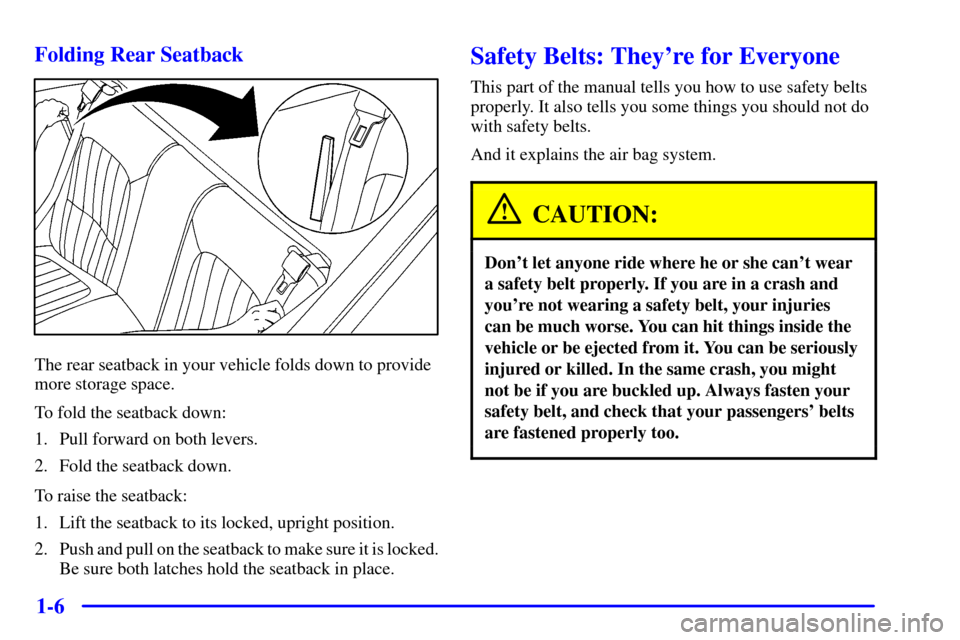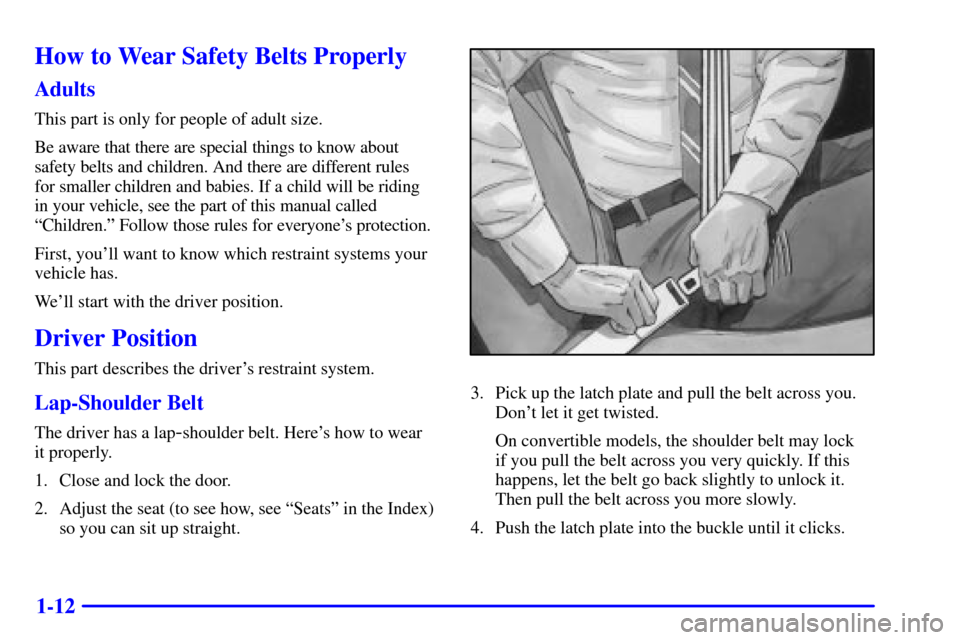Page 18 of 357

1-6 Folding Rear Seatback
The rear seatback in your vehicle folds down to provide
more storage space.
To fold the seatback down:
1. Pull forward on both levers.
2. Fold the seatback down.
To raise the seatback:
1. Lift the seatback to its locked, upright position.
2. Push and pull on the seatback to make sure it is locked.
Be sure both latches hold the seatback in place.
Safety Belts: They're for Everyone
This part of the manual tells you how to use safety belts
properly. It also tells you some things you should not do
with safety belts.
And it explains the air bag system.
CAUTION:
Don't let anyone ride where he or she can't wear
a safety belt properly. If you are in a crash and
you're not wearing a safety belt, your injuries
can be much worse. You can hit things inside the
vehicle or be ejected from it. You can be seriously
injured or killed. In the same crash, you might
not be if you are buckled up. Always fasten your
safety belt, and check that your passengers' belts
are fastened properly too.
Page 24 of 357

1-12
How to Wear Safety Belts Properly
Adults
This part is only for people of adult size.
Be aware that there are special things to know about
safety belts and children. And there are different rules
for smaller children and babies. If a child will be riding
in your vehicle, see the part of this manual called
ªChildren.º Follow those rules for everyone's protection.
First, you'll want to know which restraint systems your
vehicle has.
We'll start with the driver position.
Driver Position
This part describes the driver's restraint system.
Lap-Shoulder Belt
The driver has a lap-shoulder belt. Here's how to wear
it properly.
1. Close and lock the door.
2. Adjust the seat (to see how, see ªSeatsº in the Index)
so you can sit up straight.
3. Pick up the latch plate and pull the belt across you.
Don't let it get twisted.
On convertible models, the shoulder belt may lock
if you pull the belt across you very quickly. If this
happens, let the belt go back slightly to unlock it.
Then pull the belt across you more slowly.
4. Push the latch plate into the buckle until it clicks.
Page 26 of 357
1-14
The lap part of the belt should be worn low and snug
on the hips, just touching the thighs. In a crash, this
applies force to the strong pelvic bones. And you'd be
less likely to slide under the lap belt. If you slid under it,
the belt would apply force at your abdomen. This could
cause serious or even fatal injuries. The shoulder belt
should go over the shoulder and across the chest.
These parts of the body are best able to take belt
restraining forces.
The safety belt locks if there's a sudden stop or crash.
On convertible models, the safety belt also locks if you
pull the belt very quickly out of the retractor.
Page 39 of 357
1-27
Rear Seat Passengers
It's very important for rear seat passengers to buckle up!
Accident statistics show that unbelted people in the rear
seat are hurt more often in crashes than those who are
wearing safety belts.
Rear passengers who aren't safety belted can be thrown
out of the vehicle in a crash. And they can strike others
in the vehicle who are wearing safety belts.
Lap-Shoulder Belt
The rear seats have lap
-shoulder belts. Here's how to
wear one properly.
1. Pick up the latch plate and pull the belt across you.
Don't let it get twisted.
On convertible models, the shoulder belt may lock
if you pull the belt across you very quickly. If this
happens, let the belt go back slightly to unlock it.
Then pull the belt across you more slowly.
2. Push the latch plate into the buckle until it clicks.
Page 41 of 357
1-29
The lap part of the belt should be worn low and snug on
the hips, just touching the thighs. In a crash, this applies
force to the strong pelvic bones. And you'd be less likely
to slide under the lap belt. If you slid under it, the belt
would apply force at your abdomen. This could cause
serious or even fatal injuries. The shoulder belt should
go over the shoulder and across the chest. These parts
of the body are best able to take belt restraining forces.
The safety belt locks if there's a sudden stop or a crash.
On convertible models, the safety belt also locks if you
pull the belt very quickly out of the retractor.
CAUTION:
You can be seriously hurt if your shoulder belt is
too loose. In a crash, you would move forward
too much, which could increase injury. The
shoulder belt should fit against your body.
Page 58 of 357

2-
2-1
Section 2 Features and Controls
Here you can learn about the many standard and optional features on your vehicle, and information on starting,
shifting and braking. Also explained are the instrument panel and the warning systems that tell you if everything is
working properly
-- and what to do if you have a problem.
2
-2 Keys
2
-4 Door Locks
2
-6 Keyless Entry System (If Equipped)
2
-11 Hatch
2
-13 Theft
2
-14 Content Theft-Deterrent/Alarm
System (Option)
2
-17 PASS-Key� II
2
-25 New Vehicle ªBreak-Inº
2
-25 Ignition Positions
2
-27 Starting Your Engine
2
-30 Engine Coolant Heater (Canada Only)
2
-32 Automatic Transmission Operation
2
-36 Manual Transmission Operation
2
-39 Parking Brake
2
-41 Shifting Into PARK (P)
(Automatic Transmission Only)
2
-42 Shifting Out of PARK (P)
(Automatic Transmission)2
-43 Parking Your Vehicle (Manual Transmission)
2
-43 Parking Over Things That Burn
2
-44 Engine Exhaust
2
-44 Running Your Engine While You're Parked
(Automatic Transmission)
2
-45 Limited-Slip Rear Axle
2
-45 Windows
2
-47 Tilt Wheel
2
-47 Turn Signal/Multifunction Lever
2
-52 Exterior Lamps
2
-55 Interior Lamps
2
-57 Mirrors
2
-58 Storage Compartments
2
-62 T-Top Roof Panels (Option)
2
-69 Convertible Top (If Equipped)
2
-76 The Instrument Panel -- Your
Information System
2
-80 Warning Lights, Gages and Indicators
Page 60 of 357

2-3
This key is for the
ignition only.
This key is for the doors
and all other locks.
When a new vehicle is delivered, the dealer removes the
bar
-coded plugs from the door keys and gives them to
the first owner.However, the ignition keys don't have plugs. Instead,
they have bar
-coded key tags. These tags may be
removed by your dealer or even before the vehicle is
delivered to your dealer.
Each door key plug has a code on it that tells your
dealer or a qualified locksmith how to make extra door
keys. Keep the plugs in a safe place. If you lose your
door keys, you'll be able to have new ones made using
these plugs.
If you need a new ignition key, contact your dealer, who
can obtain the correct key code. In an emergency, call
Chevrolet Roadside Assistance at 1
-800-CHEV-USA�
or 1-800-243-8872 (In Canada call 1-800-268-2800).
NOTICE:
Your vehicle has a number of features that can
help prevent theft. But you can have a lot of
trouble getting into your vehicle if you ever
lock your keys inside. You may even have to
damage your vehicle to get in. So be sure you
have extra keys.
Page 61 of 357

2-4
Door Locks
CAUTION:
Unlocked doors can be dangerous.
Passengers -- especially children -- can easily
open the doors and fall out. When a door is
locked, the inside handle won't open it.
Outsiders can easily enter through an unlocked
door when you slow down or stop your vehicle.
This may not be so obvious: You increase the
chance of being thrown out of the vehicle in a
crash if the doors aren't locked. Wear safety
belts properly, lock your doors, and you will be
far better off whenever you drive your vehicle.
There are several ways to lock and unlock your vehicle.
From the outside, use your door key. If your vehicle
has the content theft
-deterrent/alarm system and it is
armed, unlocking and opening a door this way will set
off the alarm after eight seconds unless the ignition
key is inserted into the ignition. See ªContent
Theft
-Deterrent/Alarm Systemº in the Index.
To lock the door from the inside, slide the lock control
located on the door rearward.
To unlock the door, slide the lock control located on the
door forward.